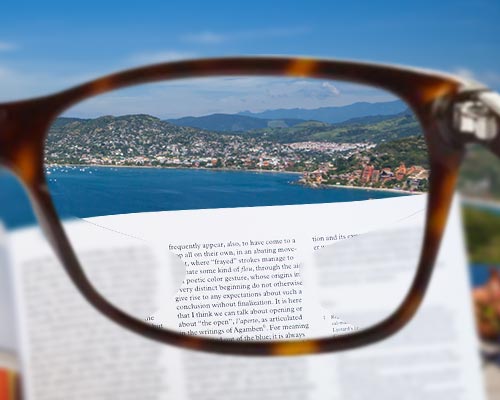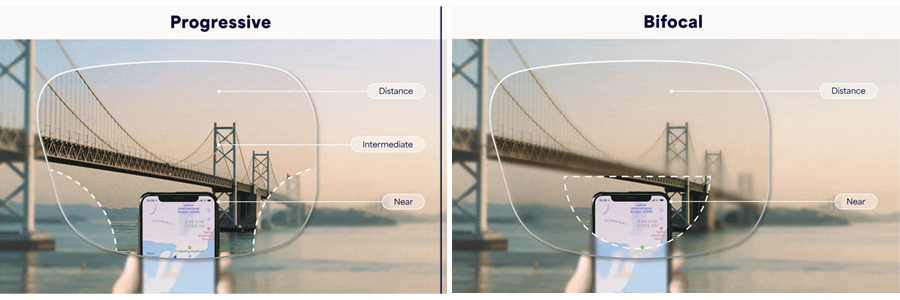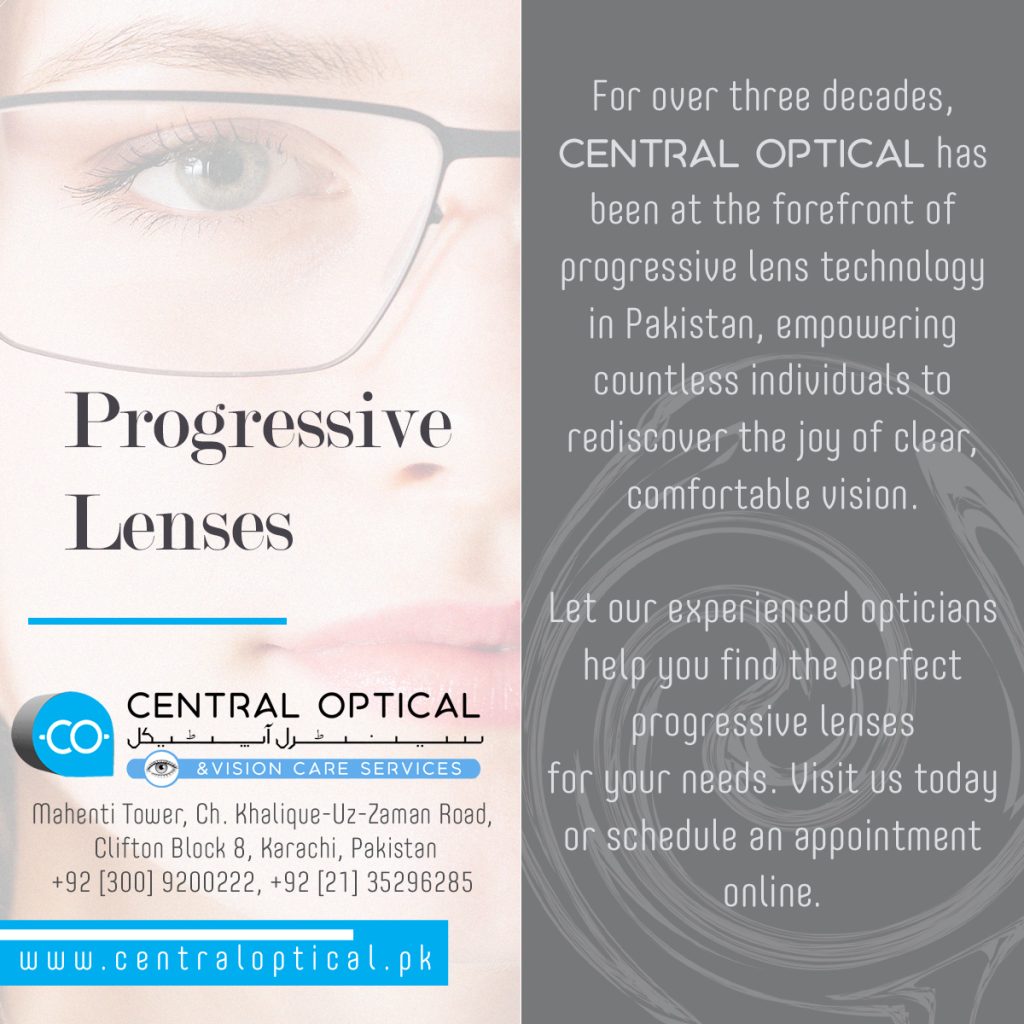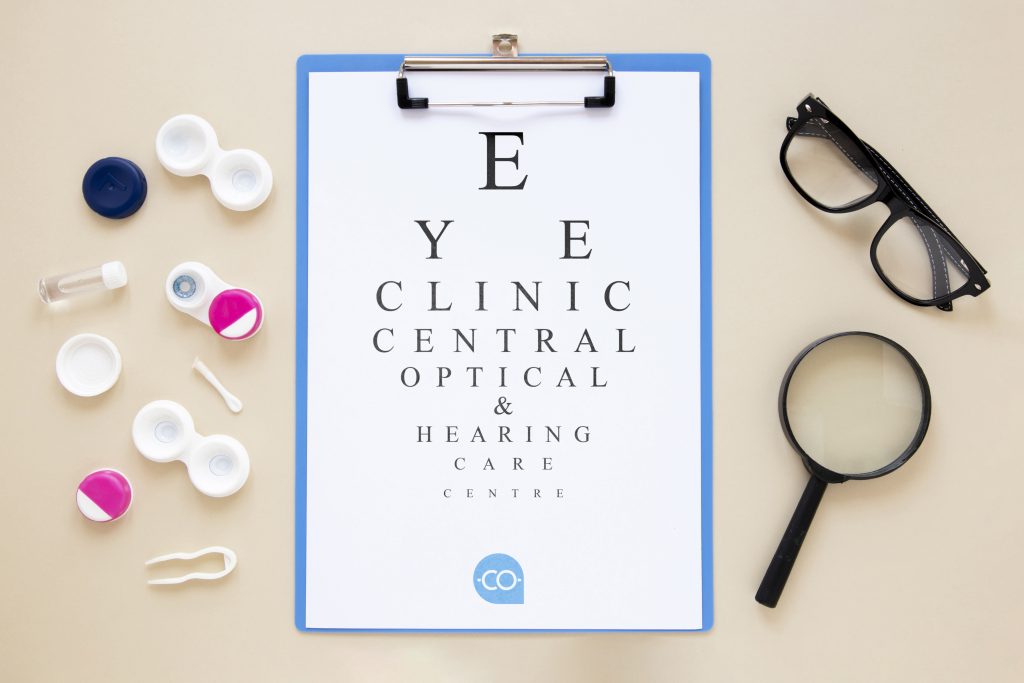Progressive Lenses
Progressive (No-Line Multifocal) Lenses are the 21st Century Solution to the old Granny style Bi-Focals (with Line Dividing far and near vision) giving excellent result for all visual Zones i.e. Far, Intermediate and Near at the same time.

Overview to Progressive Lenses
By the Time you turn 40, your Eye starts to loose it’s natural ability to shift its focus from a distant object to a near object causing difficulty in focusing on the near object and that’s when your Eye Specialist advices you to wear reading glasses.
But what if you were already using a pair of glasses for your Distant Vision (Myopia)? Now you need 2 pair of glasses, one for Far Vision & the other one for Near vision. But you also do have the option for the Old-Fashioned Granny look Bi-focal Lens which had a line in the middle separating 2 different Powers of the Lens with Far Vision on the Top & Near vision on the Bottom. But is that the look you wanna be wearing in the modern 21st Century? And what about the Intermediate vision where the Modern computers/Laptops and mobiles fall in to range.
To solve all these issues we have now Progressive Lenses in the 21st Century

What Are Progressive Lenses?
Progressive Lenses are a modern type of multifocal lens designed for people who need corrective lenses to see far away objects, Near objects like for reading or doing delicate work close to the eye and they even cover the intermediate region where usually our computers/laptops or mobile fall in the range. To put it plainly, these lenses allow you to see clearly at multiple distances without a bifocal line (no more old fashioned granny look).
The need for a progressive lens increases with age. By the age of 35 or 40, many people have difficulty focusing their eyes on nearby objects. This is known as presbyopia, and to compensate for this focusing problem, some people wear single-vision eyeglasses for distance, as well as reading glasses for close up.
While this approach can work, Progressive Lenses provide a simpler, more convenient solution to age-related vision problems, instead of two, Progressive Lenses have Multiple different focus adjustments:
- The upper section of a progressive lens provides the strength you need to see clearly in the distance.
- The lower section provides the strength you need to see clearly up close.
- The middle section helps you see clearly at intermediate or middle distances.
These lenses provide a gradual transition in strength from top to bottom.
Even though some people require progressive lenses as they become older, these lenses are also an option for children who need eyeglasses for bold nearsightedness and farsightedness.

What are the benefits of progressive lenses?
Progressive lenses aren’t only an option for correcting nearsightedness and farsightedness, they can also correct an astigmatism.
An astigmatism is when light doesn’t focus evenly on the retina due to an irregular shaped cornea, resulting in blurry vision.
Along with correcting vision problems, other advantages of a progressive lens include:
1. Only need one pair of eyeglasses
Some people find that a progressive lens is better than a single-vision lens because it allows them to see clearly at different distances without the need to carry a second pair of eyeglasses.
A progressive lens does the job of a single-vision lens and reading glasses, so that you only have one pair of glasses on hand.
2. No unsightly bifocal line
Progressive lenses offer the benefits of a multifocal lens without a multifocal line. And since there’s a gradual shift in lens strength with a progressive lens, you don’t have to deal with any sudden changes in clarity, which are common with multifocal lines.
3. Modern, youthful appearance
Bifocal and trifocal eyeglasses are sometimes associated with old age. So wearing eyeglasses with a bifocal line may make you feel self-conscious. You might feel more comfortable with a progressive lens since there isn’t a visible line.
What are the disadvantages of progressive lenses?
While a progressive lens can provide “no line” visual clarity, it’s important to understand the disadvantages of these lenses.
1. You must learn how to see through the lens
Bifocals and trifocal lenses have a visible line, so it’s easier to determine where to look for clear vision. Since progressive lenses don’t have a line, there’s a learning curve, and it might take one to two weeks to learn the correct way to look through the lens.
2. Temporary vision distortions
The lower part of a progressive lens is magnified because it’s designed for reading. So if your eyes look downward when stepping off a curb or walking upstairs, your feet may appear larger and it can be difficult to gauge your step. This can cause stumbling or tripping.
You’ll need to train your eyes to look through the distant part of the progressive lens rather than the reading part to avoid problems while walking.
Progressive lenses can also cause peripheral distortion when moving your eyes from side to side. These visual effects become less noticeable as your eyes adjust to the lenses.
3. More expensive than single-vision lenses and bifocal lenses
Keep in mind the cost difference between progressive lenses, single-vision lenses, and bifocal lenses. Progressive lenses are more expensive because you’re basically getting three eyeglasses in one.
In addition, you’re paying for the convenience and extra time that goes into creating a multifocal eyeglass with no lines.
But given the convenience and simplicity of progressive lenses, some people feel that the extra cost is worth it.

If you decide to try them, use these tips:
- Visit Central Optical so that we can guide you through the process, help you pick a good frame, and make sure the lenses are perfectly centered over your eyes. Poorly fitted progressives are a common reason why people can’t adapt to them.
- Give yourself one or two weeks to adjust to them. Some people may need as long as a month.
- Make sure you understand your eye doctor’s instructions on how to use them.
- Wear your new lenses as often as possible and stop wearing your other glasses. It will make the adjustment quicker.
- Get into the habit of turning your head to look at objects instead of moving your eyes from side to side. Peering out the side of the glasses can distort your vision.
- When reading, however, move your eyes and not your head.
Eyeglass technology is always improving. So if you’re unable to wear a progressive lens today, you might be able to wear one in the future.
How to buy progressive lenses?
At Central Optical, we offer progressive lenses from the Top Brands in the World like Nikon and Essilor – just walk in to our outlet and let us know that you are interested in Progressive Lenses. Our expert team of Optometrists and Opticians will ask you about your Life Style like daily routine, amount of time spent on Computers/laptop/mobile and Reading and driving and then based upon these findings, we will suggest you the Best Progressive Lens that will Suit your Lifestyle.



























